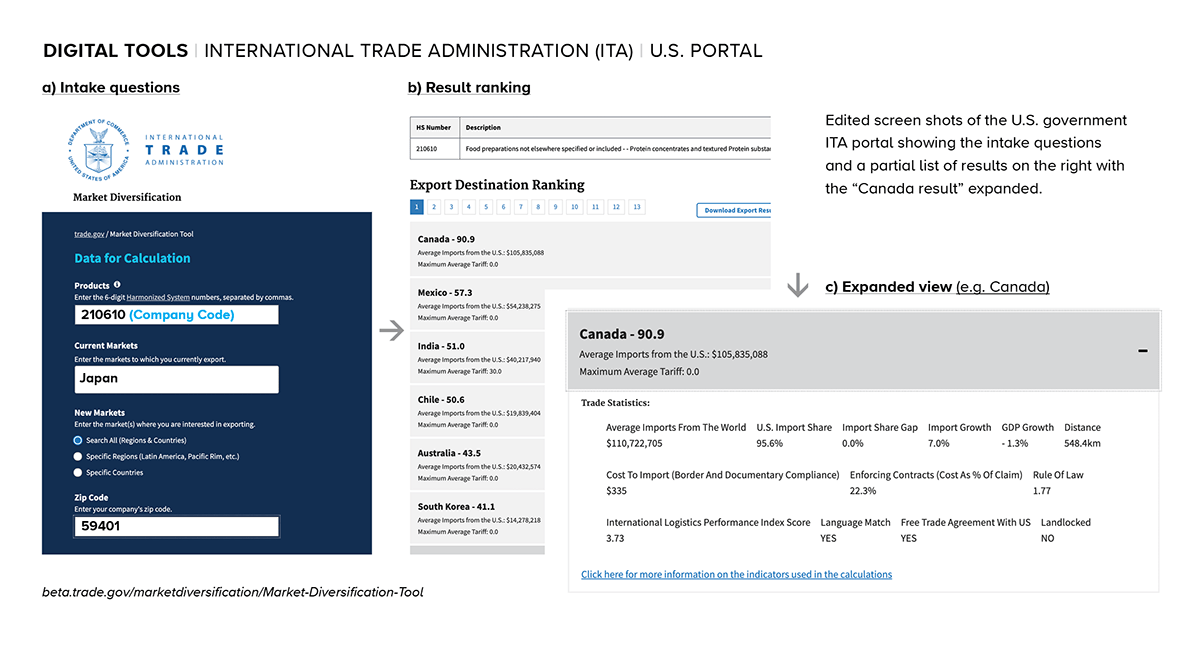Trade (Assistance) Diversification
By Carlo Dade, Director, Trade & Investment Centre
March 2020
Skip to PDF
Problem
Canada is not realizing the full benefit of new trade agreements because current mechanisms for providing export support services impose significant transaction costs that deter and thwart smaller exporters.
Solution
Online export promotion tools such as the U.S. government’s International Trade Administration Market Diversification Tool and Google Market Finder can be adopted and improved with new Canada-specific data. This will reduce the transaction costs that confront small and medium-sized enterprises (SMEs) and improve the efficiency and effectiveness of trade export support services.
Why this is needed now?
Improving the effectiveness and efficiency of export support services is important at any time. In the current context of rising and seemingly unrelenting trade tensions with our two biggest trade partners – the U.S. and China – it has become critical. New trade agreements in bigger and safer markets create incentives for SMEs to look beyond the U.S. and China. This combination of need and attractive opportunities have created a moment ripe for action.
Canada’s trade focus in the past two decades had been on agreements with mostly distant, small, less wealthy and difficult markets. For smaller exporters, these markets framed the diversification question as – why leave the ease, safety and certainty of the U.S. market for twice the work, half the money and double the risk in a country like Honduras? Canada’s new trade agreements – and recent troubling U.S. trade behaviour – have completely flipped that script. Larger markets with more opportunities in safer countries, coupled with the U.S. being less of a slam dunk, have finally given smaller exporters impetus to look further afield.
What’s stopping SMEs from seizing the new opportunities?
First, the trade agreement information available to firms is normally at a level of aggregation, the HS 2-digit level, that is of little use to SMEs. Modelling at the HS 6-digit level, as done recently by the Canada West Foundation in More Than the Usual Suspects: Western Canadian Export Opportunities to Japan under the CPTPP, provides a level of specificity that matches the product specific level and description that SMEs understand and use. Providing information at this level is key for firms to easily determine if there are opportunities for the specific items they produce.
Second, the platform for providing this information to export firms needs to be brought into the modern era. How would an SME access the kind of information recommended above? If they aren’t experienced (or even if they are) where should they start? By moving the initial export promotion agency (EPA) engagement online, it will reduce in-person transaction costs by having an expert software system analyze whether there are export opportunities that match their products, risk tolerance and other important factors. This ease of accessing information also encourages more firms to explore and consider different market opportunities. Moving the initial screening online also frees up time for EPAs to focus on those firms where the initial online screening shows good export potential. EPAs also benefit from the preliminary online analysis, allowing them to focus on value-added service to potential exporters. This should result in significant improvement in effectiveness and efficiency of EPA operations without spending increases on more manpower.
Third, SMEs that have not exported, or have exported only to the U.S. and do not use support services, have to track down and navigate a confusing list of export support service options. An Alberta SME seeking assistance faces up to a dozen different and competing agencies, all of which can provide value – municipal agencies such as Calgary Economic Development; provincial agencies such as the Ministry of Economic Development and Trade, and if the business exports food products, the Ministry of Agriculture and Forestry. At the federal level there are another half a-dozen agencies.¹ A food processor in Alberta that owns neither a tractor nor a chainsaw would be surprised to discover that help is in the Alberta Ministry of Agriculture and Forestry – not an intuitive guess. These upfront friction and transaction costs are disincentives that can stop an SME before it even considers taking advantage of new agreements to export.²

Moving online
Canada needs to develop an online digital tool that builds upon what the U.S. government has done. Interviews by the Canada West Foundation with the U.S. federal International Trade Administration (ITA) have shed light on how the Americans are advancing. They have created online tools for a simple, digital system that brings U.S. export information into an easy-to-use customer service focused portal.³ The U.S. portal is essentially a skunkworks project undertaken by technical staff in the ITA who were bothered by the same sort of issues that plague Canadian trade support services.4
For the U.S. portal, a user enters only four items: products exported, current export markets, desired export markets or regions (or all markets) and zip code. The tool compiles all the trade and tariff data related to the products the firm wants to export into three product-level indicators. The portal also includes another eight indicators about each market such as economic growth, rule of law rankings, language, and distance. The 11 indicators are normalized, weighted and then added up to give a final score for each market. The user’s zip code is used to provide the location and contact information for the nearest U.S. Commercial Service (trade commissioner) office that can assist the company. (See back page for screen shots of the U.S. portal and its outputs.)
Recently, Google has produced a similar tool, the Google Market Finder. An improved Canadian version of the portal could have the following additions to what the U.S. government ITA and Google offer.
1 A Canadian portal could provide the same sort of market analysis and ranking as the ITA portal but with obvious Canadian tweaks such as preferences for French (or other) markets.
2 A handful of additional, Canadian-specific, intake questions such as type of support desired and language capacity could be added to those that the ITA uses. But to draw in as many firms as possible, the intake questions must balance getting enough information without overwhelming SMEs new to exporting. Data from existing online services like the Canadian tariff finder could be incorporated to facilitate SMEs providing necessary information.
3 A Canadian portal could also use trade agreement impact modelling, following the CWF example, done at the HS 6-digit level. This allows SMEs to find product specific export opportunities. This is something the U.S. government ITA and Google products do not offer.
4 The online system would use an algorithm to match SMEs with EPA services the same way that potential export markets are ranked for SMEs. SMEs would receive a list of ranked relevant agencies with a brief description of services provided by each agency and links to up-to-date contact information.
5 In addition, where the ITA site identifies only the local U.S. federal trade office, a Canadian version could use postal code information to also direct users to provincial and local sources of assistance. A food exporter in Lethbridge, AB, and a services company in St. John’s, NL, would each receive different, specific export assistance sources without having to go through every EPA to try and find what they need.
6 The portal would allow SMEs to discover if there are good opportunities without investing the time and expense of meeting an EPA in person. If the portal finds opportunities, and if the SME is interested, it could elect to share the results with any or all the agencies with which it is matched. SMEs that do not need further assistance could proceed on their own freeing EPA time for those that do.
7 For SMEs that require help, EPAs would be able to review the portal information prior to meeting. Instead of trying to find firms that have good export opportunities the firms and the opportunities would be winnowed out by the portal. This would increase the effectiveness and efficiency of EPAs allowing them to focus resources on immediately providing more value-added services instead of trying to find firms.
8 Promotion efforts by each EPA would be replaced by promotion of a single portal that would be promoted persistently and extensively by all agencies. This should result in savings for trade support agencies from reduced outreach and advertising expenses in addition to eliminating confusion among SMEs.
9 Given the need for centralization, the portal would be developed, funded and maintained by the federal government. To be included in the portal, agencies would request or be invited to provide information through a standardized template. To keep this information current, agencies would be required to update the information annually or be removed from the portal.
10 Anonymized information collected by the portal would be available to researchers – to improve research and service offerings.
Conclusion
Canada’s focus on export diversification by getting firms to look at new markets opened by new agreements must be accompanied by tools that allow businesses to easily identify and take advantage of new opportunities. Federal and provincial governments have been focused on increasing traditional outreach activities and relying on the traditional architecture of providing trade support services. Rather than just adding more, the government could better achieve its diversification goals by making it easier for businesses to find helpful services. Export Development Canada and the Trade Commissioner Service are working on digital modernization efforts. The U.S. government has already moved in this direction. Using new trade agreement modelling like that tested by Canada West Foundation in More Than the Usual Suspects, Canada can not only catch up but leapfrog ahead.

1 Trade Commissioner Service, Export Development Canada, Western Economic Diversification, the Ministry of Small Business and Export Promotion and again, if food is involved, the Ministry of Agriculture and Agri-food and potentially commodity specific groups funded by the federal and provincial government to provide export support.
2 This issue was raised in interviews with export service agencies during production of the second CWF SME guide, The ‘Just in Time’ Plan: CPTPP guide for small businesses in Western Canada.
3 December 2018 and April 2019.
4 Based on conversations with ITA staff.
Series
This What Now? policy brief is part of a larger series stemming from the report, More Than the Usual Suspects: Western Canadian export opportunities to Japan under the CPTPP.
Click here to see the dates for the upcoming briefs and read the report.
